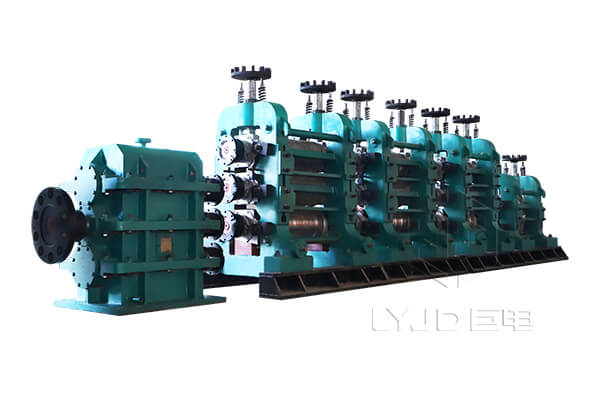A steel rebar rolling machine, also known as a rebar rolling mill, is a specialized piece of equipment used in the production of steel rebar. It is a large industrial machine that is designed to roll steel billets into long, thin bars of reinforced steel, also known as rebar.
The machine typically consists of a series of rolling stands, or pairs of rollers, through which the steel billets are passed. Each stand is designed to apply a specific amount of pressure and shape the billet into a specific size and shape. The number of rolling stands used in a rebar rolling machine can vary, depending on the desired final shape and size of the rebar.
The rebar rolling machine is typically controlled by a computerized system that monitors various parameters, such as rolling speed, temperature, and pressure, to ensure that the rebar is produced to the required specifications. Advanced sensors and monitoring systems are often used to detect any deviations from the desired parameters and make real-time adjustments to the process to ensure that the final product meets the required quality standards.
Typically, it will take several steps from billet to rebar.
Heating: The steel billets are heated in a furnace to a temperature of around 1200-1300°C (2200-2400°F) to make them more malleable and easier to shape.
Roughing Rolling
The heated billets are then passed through a series of rough rolling stands, which reduce their size and shape them into a more uniform shape.
Intermediate rolling
The billets are then passed through a series of intermediate rolling stands, which further reduce their size and shape them into a more precise form.
Finishing Rolling
The billets are then passed through a series of finishing stands, which give them their final shape and size.
Cooling
The finished rebar is then cooled using a water spray or air cooling system to ensure that it maintains its desired properties.
Cutting and bundling
The cooled rebar is then cut to the desired length using shear and may be bundled and labeled for shipment to customers.
Depending on different classification methods, there will be many types of rebar rolling machines. Here, we just list two common types of rebar rolling machines.
Two-high Rebar Rolling Machine
This is the simplest type of rebar rolling machine, consisting of two rollers that rotate in opposite directions to shape the steel billet into a desired shape. In most steel-making factories, we can find this type of rebar rolling machine.
Continuous Rebar Rolling Machine
This type of machine is for high-volume production and operates continuously, with the steel billet being fed into the machine at one end and the finished rebar exiting at the other end. This allows for a high degree of automation and efficiency in the production process. This type of rebar rolling machine consists of several rolling stands to complete the rolling work.

There are many other types of rebar rolling machine that is not listed here. If you want to learn more, please refer to this.
The power required to drive a rebar rolling machine depends on several factors, including the size and type of the machine, the size and shape of the steel billets, and the desired final shape and size of the rebar. Generally, larger and more complex machines require more power than smaller and simpler machines.
The power required to drive a rebar rolling machine is typically measured in horsepower (HP) or kilowatts (kW). The power requirements can vary widely depending on the specific machine and application. For example, a small two-high rolling mill may require a few hundred horsepower, while a large multi-stand rolling mill may require several thousand horsepower.
In addition, there are many other factors that can also affect the power consumption of the rolling mill. These include the efficiency of the motor and transmission system, the rolling speed, and the amount of friction between the rollers and the steel billet. Efficient operation of the rolling mill and proper maintenance of the equipment can help to minimize power consumption and reduce operating costs.
Insufficient power can cause a rebar rolling mill to operate below its designed capacity, resulting in reduced productivity and potential quality issues.
Below are the power supply and other specifications of some models of rebar rolling machines.
| Model | Power(kW) | Rolling Speed(m/s) | Feed Section(mm) |
| H200-2 | 90 | 1.5 | 30*30 |
| H220-2 | 95 | 1.5-2 | 40*40 |
| H250-3 | 180 | 1.8-2.5 | 50*50 |
| H250-4 | 315/240 | 2.5-4 | 60*60 |
| H250-5 | 500 | 2.5-5 | 50*50 |
| H280-5 | 630 | 2-2.5 | 70*70 |
| H300-5 | 680 | 2-2.5 | 90*90 |
| H350-5 | 800 | 2-2.5 | 90*90 |
The rebar rolling machine is a critical piece of equipment in the production of steel rebar. Therefore, its proper functioning is crucial to ensuring the safety and durability of concrete structures such as buildings, bridges, and highways.
Please send us your request and we reply to you with in 24 hours.
Submit Request